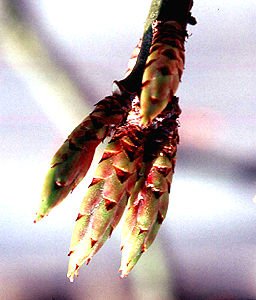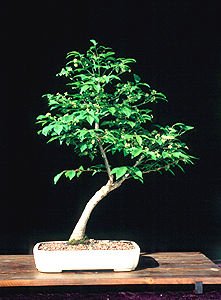Dwarf Burning Bush (Euonymus alatus compactus)
Spotlight On A Tree
by Reiner Goebel
Dwarf Burning Bush(Euonymus alatus compactus)October 2000
Euonymus or Spindle tree is a genus of approximately 175 species of deciduous, semi-evergreen and evergreen shrubs, trees and climbers found growing mainly in Asia. The Euonymus alatus is called Burning bush or Winged spindle tree for the broad, corky wings that adorn its branches.
The Dwarf burning bush (Euonymus alatus compactus) lacks this ‘feature’ and is therefore better suited for bonsai. In addition, its branching is finer and its leaves are smaller.
Burning bush is a popular garden plant because if its intense red foliage colour in fall. While Japanese maples will produce good fall colour even when grown in a good deal of shade, Burning bush needs full sun exposure for best results. I find this plant likes a good supply of moisture during spring and summer, and I therefore grow mine in fairly deep pots.
I started growing Burning bush as bonsai in 1992, and since then have had only one recurring problem: branch dieback just as the new growth begins to elongate in spring. However, this dieback usually does not affect the whole branch, but only the fresh elongation.
Another drawback in bonsai culture is the plant’s habit of producing only one shoot elongation per growing season. When a branch is pruned, the new buds produced in the leaf axils will not open until the next spring, making the development of ramification a slow process.
Among its strong points, other than fall colour, are: … Hardiness in zones 4 to 9 (average minimum temperature from -34C to -1C) … Beautiful bark even in young plants … Adaptability to life in a container … Buds back well on old wood … Naturally small leaves that reduce even more in bonsai culture … Bright orange ‘berries’ in fall and winter
Branches have to be wired very carefully, because the fat buds are only attached very loosely and can easily be knocked off.
All in all, I think Dwarf burning bush makes a very good subject for bonsai and deserves to be grown more frequently. I hope the following pictorial will prove the point.
I inherited the tree below when a bonsai acquaintance of mine died in a car accident early in 1998 and his widow thought he would have liked me to look after his collection.
















